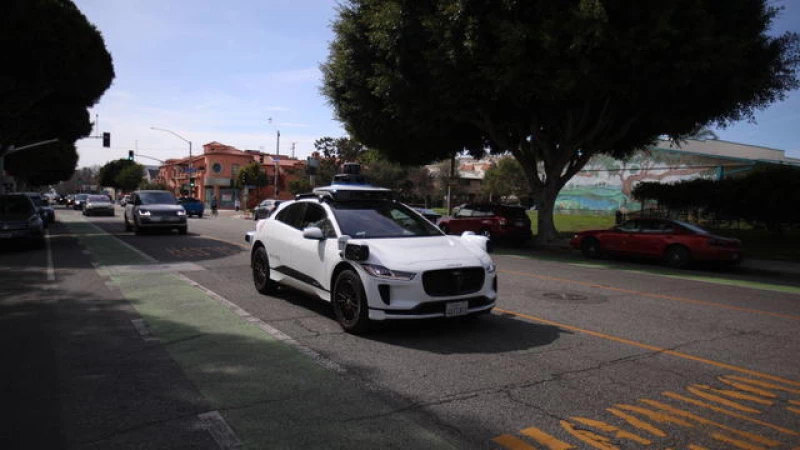Self-driving cars have long been hailed as the future of the automotive industry, yet the software that powers these vehicles remains firmly rooted in the present.
Experts point to a significant flaw in current self-driving systems that has yet to be resolved. When faced with the potential for an accident, these systems often relinquish control back to the human driver at a moment's notice, leaving them with insufficient time to avert a collision, industry insiders revealed. This lack of adaptability means that the software struggles to react to unexpected events, such as an animal suddenly appearing on the road.
This critical flaw was starkly highlighted earlier this year when a Ford Mustang Mach-E SUV collided with a 56-year-old Texas man behind the wheel of a Honda CR-V. The Mach-E was equipped with its semi-autonomous driving feature, known as BlueCruise, at the time of the accident, which tragically resulted in the death of the CR-V driver. In response, the National Highway Traffic Safety Administration (NHTSA) announced on Monday that it is launching an investigation into the potential role played by BlueCruise in the Texas crash.
Recently, the National Highway Traffic Safety Administration (NHTSA) initiated an investigation into self-driving vehicles, marking another instance in a series of inquiries. This particular probe, named BlueCruise, follows a previous investigation in 2022 regarding the functionality of robotaxis operated by General Motors' Cruise autonomous software, which experienced sudden stops or complete halts. NHTSA has also delved into multiple incidents involving Tesla's autopilot feature dating back to 2021.
These investigations by NHTSA highlight the ongoing challenges in the advancement of autonomous driving technology. Despite being touted as the next competitive frontier for automakers, the technology has not yet reached a level of maturity suitable for widespread adoption. Robert Sumwalt, a transportation safety analyst at CBS News, emphasized this point, comparing the current state of autonomous driving to attempting to send a rocket to the moon in 1910 while the Wright Brothers were still perfecting their airplanes.
Exploring the Realm of Vehicle Autonomy
Most modern vehicles with self-driving capabilities operate at what is known as Level 2 autonomy within the industry. There are a total of six increasing levels of autonomy established in the field. At Level 2, a vehicle is equipped with an onboard computer containing a detailed map database. Additionally, the vehicle is fitted with camera sensors, radars, lidar (light and range detection), and ultrasonic systems, all working in unison to monitor the vehicle's surroundings in real-time.
"The maps they have on them can drive perfectly, if there's nothing on the road," mentioned Sean Tucker, senior editor at Kelley Blue Book and Autotrader. "It's a problem if someone stops in the middle of a highway or if a deer runs out in the middle of the road. That's the hard part for the computer."
Ford's BlueCruise functions as a Level 2 system, allowing drivers to remove their hands from the steering wheel while the vehicle manages steering, braking, and acceleration on highways. A Ford spokesperson expressed aspirations to enhance BlueCruise to Level 3 autonomy, which would enable the vehicle to execute more advanced tasks such as overtaking a slow driver or moving forward in a traffic jam.
"By enabling hands-free, eyes-off driving in certain conditions like long stretches of highway or stop-and-go traffic, this technology has the potential to offer drivers the freedom to use their time behind the wheel in more productive and enjoyable ways during parts of their journey," the Ford spokesperson communicated to CBS MoneyWatch via email.
Similar to many other prominent automakers, Ford is heavily investing in self-driving vehicles. The company established its own internal division for automated driving systems called Latitude AI last year, dedicated to enhancing BlueCruise.
At a 2023 company event, Ford's electric vehicle chief Doug Field outlined the aggressive approach the automaker is taking towards self-driving technology.
"We want L3 to work everywhere BlueCruise works," he said. "The key use cases that we see are stop-and-go traffic — which is really tedious and actually a cause of a lot of accidents because people take their mind off of what's going on — and then steady-state cruise long trips, in which, the same thing, you can tend to get bored or sleepy."
Race for the Holy Grail
Self-driving cars are much more advanced now compared to when they were first developed, said K. Venkatesh Prasad, senior vice president of research at the Center for Automotive Research. Still, they have to be able to navigate, not only humans driving cars and trucks, but people making unpredictable moves on scooters, skateboards and bicycles, Prasad told CBS MoneyWatch.
Automakers are testing their self-driving cars on closed tracks as much as they can, but they can advance the technology faster by putting the vehicles on an actual road, Sumwalt said. But real-world testing, he said, comes at a high price — crashes, fatalities and federal investigations.
Indeed, Ford, GM, Mercedes-Benz, Nissan, Subaru and Tesla all have a variation of Level 2 autonomous driving. They're all in a technology arms race to perfect self-driving and claim all the benefits that come with it, experts said.
"If you can be first to this Holy Grail of autonomy, you get a lot of attention," said Jonathan Elfalan, director of vehicle testing at Edmunds. "And you are probably going to make profit off the end of it."







